Navigating the World of Cage-Free Pet Birds
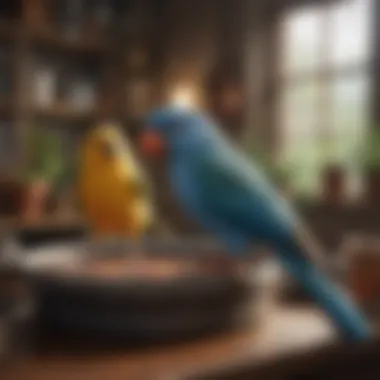
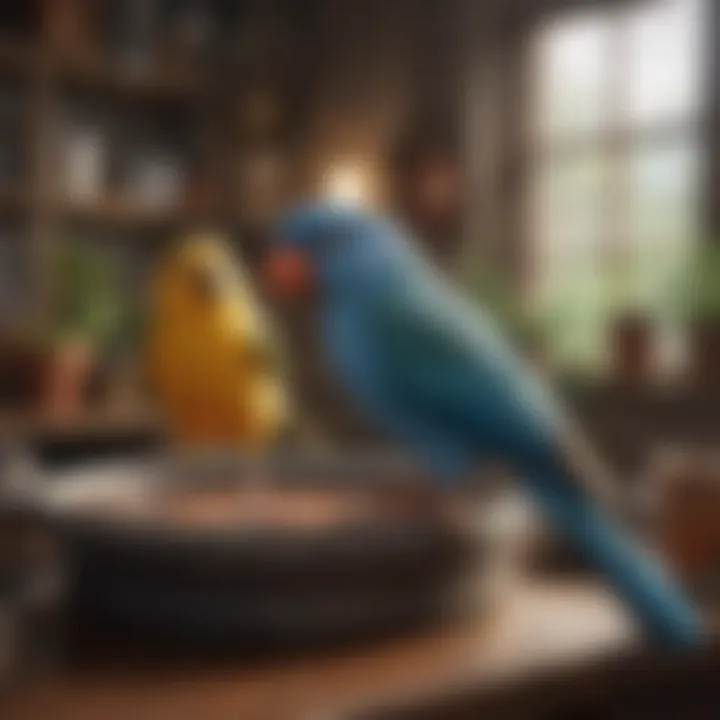
Intro
Keeping pet birds without cages offers a unique opportunity to foster a more natural living environment. This approach comes with distinct advantages and challenges worthy of exploration. Understanding the dynamics at play is critical for both the well-being of the birds and the practical aspects of their care.
This article examines the core considerations in maintaining pet birds without cages. It emphasizes the importance of creating secure environments, delving into the behavioral insights necessary for bonding with these avian companions, and explores relevant health and nutrition practices. Through a meticulous examination of best practices and safety measures, bird owners can develop informed strategies for ensuring a fulfilling experience for their pets while maintaining the necessary responsibility.
Care Tips
Caring for pet birds outside of conventional cages requires diligent attention to their daily routines and habits. Establishing a consistent care regimen is essential for their overall health and well-being.
Daily Care Routines
Birds thrive on routine. Daily tasks should include feeding, cleaning their living spaces, and providing interaction. Birds need a balanced diet rich in seeds, fruits, and vegetables. Regularly observing their behavior helps identify any health issues early. Setting aside specific times for these activities strengthens the bond between bird and owner.
Hygiene and Cleaning Practices
Maintaining hygiene is pivotal. Without a cage, birds may come into contact with various surfaces, resulting in a greater risk of exposure to dirt and pathogens. Regular cleaning of their environment is crucial, including disinfecting surfaces and removing waste promptly. Using bird-safe cleaning products helps ensure their living area remains healthy.
Seasonal Care Adjustments
Adjusting care routines according to the seasons is important. During colder months, it's vital to ensure that the living environment is warm enough. Provide ample sunlight exposure during spring and summer while being cautious with temperatures. This attentiveness aids in a bird’s adaptability and comfort.
Behavioral Insights
Understanding how birds communicate and express their needs is crucial for maintaining positive interactions. Observing their body language can reveal a lot about their well-being.
Understanding Bird Body Language
Birds display various physical cues to express moods. Raised feathers signify excitement or distress. A retreat or subtle movements may indicate fear. Recognizing these signals can help identify their emotional states, leading to better care practices.
Common Behavioral Issues and Solutions
Behavioral challenges can arise, particularly when birds are not caged. Issues like excessive squawking or aggressive behavior may occur due to stress or boredom. Providing distractions, such as toys or companionship, can mitigate these issues. Consulting with avian behaviorists can assist in developing tailored solutions for specific problems.
The key to a harmonious relationship with pet birds lies in understanding their behavior and responding appropriately to their needs.
Positive Reinforcement Techniques
Utilizing positive reinforcement fosters trust and encourages desired behaviors. Rewarding birds with treats or verbal praise when they exhibit good behavior reinforces positive actions, making the training process effective.
Nutrition Guides
Proper nutrition is paramount for overall health. Understanding the dietary requirements of specific bird species aids in providing balanced meals.
Essential Diet Components
A varied diet that includes seeds, pellets, fruits, and vegetables is essential. Each bird species has different nutritional needs. Researching dietary specifics will help ensure they receive adequate nutrients.
Safe and Toxic Foods
Knowledge of safe versus toxic foods cannot be overlooked. Avocados, chocolate, and certain nuts can be dangerous. Providing information about safe food options helps prevent potential health crises.
Supplements and Treats
Adding vitamins and minerals can also supplement their diet. Ensure any supplements are appropriate for their species and age, following veterinarian guidance.
Wellness and Health
Regular health checks and preventive care form the foundation of a bird's well-being.
Routine Health Checkups
Establishing a schedule for veterinarian visits is advisable. Frequent check-ups facilitate early detection of health issues, helping avoid complications.
Identifying Symptoms of Illness
Birds can be adept at hiding illness. Awareness of subtle changes in behavior, appetite, or physical appearance can be life-saving.
Preventative Care and Vaccinations
Incorporating vaccinations into their health regimen is significant. Preventative care not only boosts immunity but also contributes to their mental and emotional well-being.
Enriching Activities
Interactive activities play a vital role in keeping birds mentally stimulated. Engaging in creative and playful activities strengthens the bond between human and avian companions.
Toys and Playtime Ideas
Providing a range of toys supports cognitive stimulation. Rotating options can help maintain their interest. Simple DIY projects can also offer enrichment while being gentle on the budget.
Training and Tricks
Teaching birds easy tricks can be very fulfilling. Training sessions help in developing trust and a deeper bond.
Outdoor Activities and Interaction
Supervised outdoor time exposes birds to natural elements. Birds benefit from a change of scenery, improving their overall health.
As pet owners approach the intricacies of caring for birds without cages, they must remain committed to understanding their pets’ needs. This not only enhances the bond between human and bird but also contributes to a fulfilling and enriched life for the avian inhabitants.
Understanding Bird Behavior
Understanding bird behavior is foundational for anyone considering keeping pet birds without cages. A comprehensive grasp of avian behavior allows owners to create environments that cater to the innate needs of their feathered companions. Recognizing patterns, social structures, and instinctual behaviors transforms the relationship between birds and their owners. This understanding elevates care practices and enhances the overall wellness of pet birds.
Natural Instincts of Avians
Birds, as a species, have evolved with specific instincts that play vital roles in their survival. These instincts include foraging for food, seeking shelter, and socializing with others of their kind. Understanding these natural behaviors is essential for any owner who wishes to provide an uncaged lifestyle.
For example, wild birds naturally spend much of their day looking for nourishment, interacting with their flock, and protecting themselves from predators. In a cage-free environment, it is crucial to simulate some of these conditions. Providing various foraging opportunities can replicate their natural foraging instincts. Owners can scatter seeds around their home or use toys that encourage foraging behavior. This not only keeps birds physically engaged but mentally stimulated as well.
Social Structures and Communication
Birds are inherently social creatures. Many species thrive on interaction, not just with fellow birds but also with humans. Understanding the social structures among birds can help owners foster positive environments. Some species, such as parrots, are particularly known for their communicative nature.
Keeping birds in separate spaces or isolated from interaction may lead to behavioral issues. Birds often communicate through vocalizations, body language, and even subtle cues in their behavior. Recognizing and interpreting these signals can help owners respond appropriately to their birds' needs. Engaging with them through active play or conversation can significantly enrich their lives.
Instinctual Needs of Pet Birds
Beyond mere social interaction or foraging, pet birds have specific instinctual needs that require attention in a free-range environment. For example, many birds require areas to fly and exercise. This includes height variation, where they can flit from perch to perch, mimicking the tree-dwelling behaviors of many wild species.
Additionally, the instinct to nest is evident in many birds. Introducing safe nesting materials can satisfy this need. A well-rounded understanding of these needs is integral. It equips bird owners with the tools necessary to create a fulfilling environment that promotes overall well-being for their pets.
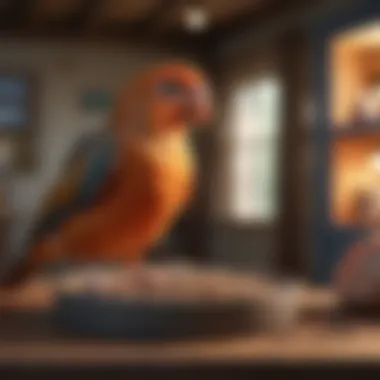
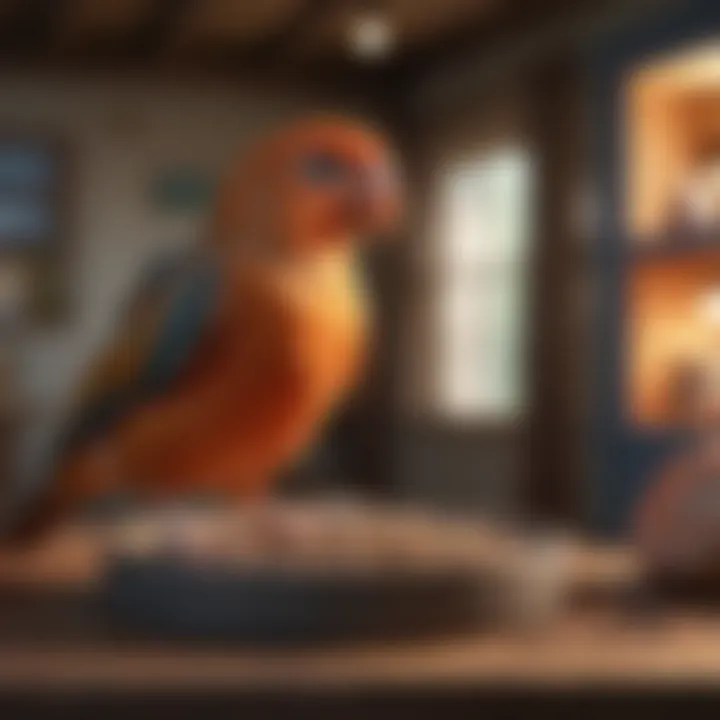
"Birds require physical and mental stimulation. Understanding their behavior helps in providing an enriching life."
Ultimately, the key to good pet bird care lies in the comprehension of what makes them tick. The better an owner understands the intricacies of bird behavior, the more equipped they are to support their avian companions. This knowledge leads to happier and healthier birds, fostering strong bonds and fulfilling relationships.
Benefits of Cage-Free Living
Keeping pet birds without cages presents several benefits that can greatly enhance their quality of life. In this section, we will explore three main advantages: enhancing physical activity, improving mental stimulation, and strengthening human-bird bonds. Understanding these benefits helps pet owners appreciate the value of a cage-free lifestyle for their avian companions.
Enhanced Physical Activity
Allowing birds to live without cages encourages more physical activity throughout their day. Birds, by nature, are active creatures that thrive on movement. When confined to a cage, their ability to fly or climb is severely limited, which can lead to boredom and health issues over time.
In an uncaged environment, birds can spread their wings and engage in spontaneous flying. This leads to improved muscle tone and overall cardiovascular health. For instance, birds will often enjoy perching at various heights, which not only mimics their natural habitats but also encourages exercise as they move between different surfaces. Consider the following arrangements to facilitate physical activity:
- Open spaces: Ensure there are safe areas where birds can fly freely.
- Ramps and perches: Provide diverse perching options for climbing and enhancing leg strength.
- Play areas: Designate specific areas for play that encourages exploration and movement.
Improved Mental Stimulation
Mental stimulation is another crucial element of a bird's well-being. Birds are intelligent and require varied stimulus to keep their minds engaged. Living cage-free allows for a more enriching environment that stimulates curiosity and problem-solving skills.
Pet owners can foster mental engagement through diverse activities. Here are a few methods:
- Interactive toys: Introduce toys that challenge their intelligence, such as puzzle feeders or foraging toys.
- Social interaction: Regular interaction with owners or other birds can keep their minds sharp. Birds are social creatures and thrive on companionship.
- Environmental changes: Rotating toys and rearranging their surroundings can spark curiosity and encourage exploration.
Engaged birds lead to balanced behaviors and can develop fewer behavioral problems.
Strengthened Human-Bird Bonds
A significant advantage of keeping birds uncaged is the opportunity to foster stronger bonds between the bird and its human companions. When birds are not restricted by cages, they generally become more social and affectionate. They learn to trust their owners and often display more personality as they feel secure in their environment.
Engaging in daily interactions can lead to a deeper relationship. Here are some effective strategies to strengthen bonds:
- Routine interaction: Spend consistent time with your bird, whether through talking, playing, or simple observation.
- Training: Basic training sessions can help reinforce trust and understanding. Use positive reinforcement to encourage desired behaviors.
- Shared exploration: Allow birds to explore their safe environment while you observe. This not only facilitates bonding but gives them confidence.
Embracing the benefits of cage-free living means providing an open environment that caters to a bird's physical, mental, and social needs. By considering these aspects, pet owners can ensure a fulfilling life for their birds, contributing positively to their welfare.
Assessing Risks and Challenges
Assessing risks and challenges is a critical component of keeping pet birds without cages. This consideration not only affects the wellbeing of the birds but also the peace of mind of the caregivers. Understanding potential hazards allows bird owners to create safer living environments. Considering health risks, predator threats, and the risk of escape are vital aspects to ensure both the safety of the birds and the efficacy of their cared-for lifestyles.
Health Risks from Exposure
Keeping birds uncaged can expose them to a variety of health risks. Common household items can be toxic to birds. Chemicals found in cleaners, scented candles, and even some houseplants pose significant threats. Birds have very sensitive respiratory systems. Even exposure to fumes, like smoke from cooking, can lead to serious health issues.
To minimize these risks, it is important to maintain a clean environment. Avoid using harsh chemicals near the birds. Instead, opt for bird-safe cleaning products. Also, providing proper ventilation helps mitigate the accumulation of harmful substances. Additionally, it is crucial to monitor the bird's health closely. Regular check-ups with an avian veterinarian should be scheduled to ensure that any health issues are addressed promptly.
Predator Threats
Predators are another concern for uncaged birds. Natural predators include cats, dogs, and even raptors. When birds are allowed to roam freely, they may become easy targets for these animals. Even in seemingly safe environments, the potential for predation exists. This risk extends to birds that may be taken by larger birds or other wildlife.
One effective measure to mitigate predator threats is to supervise birds when they are outside. Establishing a secure outdoor area can also help. Use structures like aviary netting to create safe zones. This just might provide respite from natural threats while allowing birds to enjoy the outside world. Furthermore, understanding the local wildlife is essential. Knowing which predators are likely to enter your area can help in planning protective measures.
Risk of Escape
While nurturing the freedom of uncaged birds, escape can quickly become a significant problem. Birds are naturally curious and often seek new experiences. Leaving windows or doors open, even for a moment, can lead to an unintentional escape. The instinctual flight of the bird can take it far away from home, creating a real danger for the pet and potentially leading to distress for the caregiver.
To minimize this risk, owners should ensure all entry points are secured. Installing screens on windows can allow birds to enjoy the breeze without the risk of flying out. Training birds to return to a designated area may also aid in escape prevention. In addition, utilizing harnesses and leashes for outdoor excursions provide both freedom and security, allowing birds to explore while remaining safe from escaping.
Assessing these risks enables pet bird owners to make informed decisions related to the environment and care of their avian companions. By being aware of health concerns, predator threats, and the risk of escape, caregivers can foster a safe, enriching, and harm-free experience for their pets.
Designing A Safe Environment
Creating a safe environment for pet birds is essential to their wellbeing and overall health. Unlike traditional pets, birds have unique needs that require careful planning and consideration. A well-designed space can help minimize risks while maximizing comfort and stimulation.
Birds thrive in environments that mimic their natural habitat as closely as possible. This means offering vertical space for flying and perching, as well as opportunities to engage with their surroundings. Environmental design is not just about preventing escapes; it also involves creating a stimulating and nurturing area for birds to flourish. Carefully structured environments can significantly reduce issues such as stress and behavioral problems.
Safety and comfort are interlinked. Without one, the other can’t exist.
Creating Safe Spaces
To establish safe spaces for pet birds, one must first identify suitable areas in the home. These areas should be free from hazards such as open windows, toxic plants, or small objects that could be swallowed. It is beneficial to dedicate specific zones for avian activities. Using soft, non-toxic materials for flooring can also cushion falls, reducing injury risk.
Bird owners should consider the height of the space. Birds feel secure when they can perch at high levels. Tall shelves or stands can provide them with the vertical space they crave. Additionally, placing natural branches in these places can offer comfort and a sense of security. It is also vital to integrate hideaways so the birds can retreat if they feel overwhelmed.
Utilizing Natural Barriers
Natural barriers can further enhance the safety of an uncaged environment. These barriers can include structures like plants or decorations that limit access to unsafe areas. Bird-safe plants can act as well as beautiful separators. Owners should choose thick, sturdy plants that birds cannot easily topple over.
Using wire mesh can be a good option as well. For instance, setting up wire fencing around certain areas can keep birds safe from other pets or potential dangers. Ensuring there is no way for them to slip through while allowing fresh air to circulate is key. All these measures create a more secure area for exploration.
Essential Enrichment Tools
Enrichment tools are vital for any cage-free environment. These can include various toys, mirrors, and perches that keep birds mentally and physically engaged. Variety is important; switching out toys regularly prevents boredom and fosters curiosity.
Interactive toys that encourage problem-solving can stimulate mental activity. Puzzle feeders, for example, require birds to work for their food, making mealtime more engaging. Also, providing diverse perching options can help with muscle tone and foot health.
Owners should be careful to select materials for toys that are safe, avoiding anything with harmful chemicals or small parts that could pose choking hazards. Even safe wood or plastic should be evaluated for wear and tear to ensure that birds do not ingest harmful pieces.
Daily Care for Uncaged Birds
Caring for uncaged birds is a commitment that requires attention and consistency. The well-being of these birds depends heavily on daily care practices. Without the confines of a cage, day-to-day maintenance takes on more significance. This section delves into essential aspects of caring for pet birds that live without cages, emphasizing their dietary needs, grooming habits, and health check procedures.
Dietary Requirements and Nutrition
Providing a balanced diet is crucial for uncaged birds. Unlike their caged counterparts, these birds have more opportunities to forage. This ability can be both beneficial and challenging. It is important to offer a variety of foods, ensuring they receive adequate nutrients. A bird's diet typically includes:
- High-quality pellets: These should be the foundation of the diet. They provide essential vitamins and minerals.
- Fresh fruits and vegetables: Options like carrots, berries, and leafy greens are not only nutritious, but they also satisfy birds' foraging instincts.
- Seeds as treats: While many birds love seeds, these should be a supplementary treat to avoid obesity.
Regularly changing the food items keeps meals interesting and encourages natural behaviors. Monitoring food intake is also necessary. Birds that eat less can be a sign of health issues, so keeping an eye on any changes is vital.
Grooming and Hygiene Practices
Grooming is an important part of daily care for uncaged birds. Unlike in cages, where birds may be unable to engage in certain grooming behaviors, uncaged birds have more freedom. They can preen their feathers, which keeps them clean and healthy. However, some grooming practices still require intervention:
- Bathing opportunities: Providing a shallow dish of water or a gentle mist can encourage birds to bathe. Frequent bathing helps to maintain feather quality.
- Beak care: Wooden toys can assist with natural beak wear. Observing the beak shape is crucial for spotting any abnormalities.
- Nail trimming: Regular checks are essential, as nails can become overly long without natural wear and tear. If necessary, trim nails carefully or consult a vet.
Maintaining hygiene helps keep birds healthy. Regular spot cleaning of their spaces and monitoring for signs of illness are also good practices.
Health Check Procedures
Frequent health checks are imperitive for uncaged birds. Observing behavior and physical appearance can provide early warning signs of health issues. Some procedures to consider include:
- Behavior observation: Changes in vocalization or activity can indicate stress or health problems.
- Physical inspection: Checking for signs like feather loss, eyes clarity, and droppings consistency helps in assessing overall health.
- Routine vet visits: Establish a schedule with an avian vet to ensure preventive care and vaccinations if necessary.
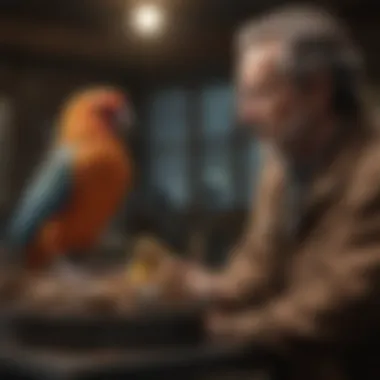
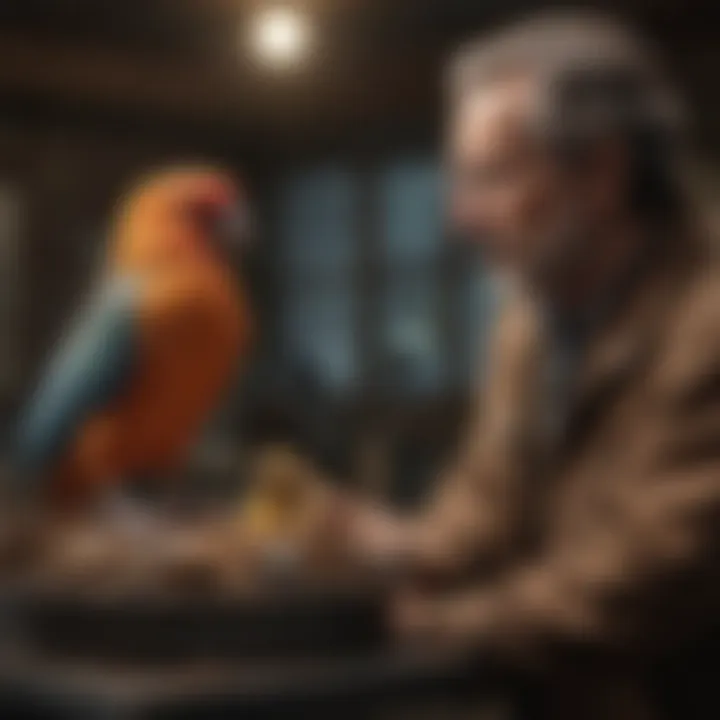
Regular health assessments help in early detection of issues, which can significantly improve outcomes for birds.
Setting up a good routine for care can help maintain a long and healthy life for uncaged birds. Combining proper nutrition, regular grooming, and routine health checks forms the basis of a flourishing environment for avian companions.
Behavior Management Techniques
The management of bird behavior is crucial when keeping pet birds without cages. Understanding how to respond to various behaviors can help foster a peaceful environment for both birds and their owners. Effective behavior management involves recognizing natural instincts, setting boundaries, and engaging in positive reinforcement techniques. This not only ensures a harmonious home but also nurtures the birds’ emotional and psychological health.
Understanding Aggression
Aggression can manifest among pet birds for many reasons. However, it is often rooted in their instinctual behavior. Birds are territorial creatures and may react aggressively when they feel their space is threatened. Identifying the triggers of aggression is essential for management. Common triggers include changes in their environment or the introduction of new birds or people.
When signs of aggression appear, such as biting or loud squawking, it is crucial to respond calmly. A sudden reaction can escalate the situation. Instead, owners should try to understand the cause. It may be necessary to provide a quiet space for the bird to retreat. Training can also play a role in minimizing aggressive behavior. Teaching commands such as "step up" can facilitate better interactions.
Promoting Positive Interactions
Creating positive interactions between birds and humans or other pets is vital to their socialization. Birds thrive on social engagement and feel secure when they can interact constructively. Regular, gentle handling can build trust. Owners can encourage trust by allowing the bird to come to them at its own pace.
Engaging in activities like target training or playing with toys can enhance these interactions. Positive reinforcement, such as treats or praise when birds exhibit desired behaviors, should be employed. This method not only promotes good behavior but strengthens the bond between the owner and the bird.
Addressing Stress and Anxiety
Stress and anxiety in birds can lead to unwanted behaviors. External factors such as loud noises, unfamiliar environments, or changes in routine can significantly impact a bird's well-being. Owners should observe their birds for signs of stress, which may include feather plucking, excessive vocalization, or withdrawal.
To mitigate stress, creating a safe and stable environment is essential. It is helpful to maintain a consistent routine for feeding and handling. Using calming products, such as bird-safe herbal remedies or soothing music, can also help keep anxiety at bay. Always monitor the bird's behavior closely during stressful situations and intervene with patience and understanding.
Socialization of Pet Birds
Socialization plays a crucial role in the overall well-being of pet birds, especially when they are kept without conventional cages. It goes beyond mere interaction; it encompasses the relationships that birds build with their human caretakers and fellow birds. Proper socialization can lead to a more balanced, happy, and well-adjusted pet, enhancing the bond between bird and owner.
Interactions with Humans
Human interaction is fundamental for the socialization of pet birds. Birds are naturally social creatures, and they thrive on companionship. When a bird is raised in a nurturing environment where it frequently interacts with humans, it learns to trust and rely on them. Such interaction can take many forms, including:
- Talking and Whistling: Engaging with your bird using friendly sounds can create a sense of security and comfort.
- Handling and Cuddling: Gentle handling helps the bird to familiarize itself with human touch, which can reduce stress during routine care.
- Creating Playtime: Engaging your bird in play also helps to build a deeper bond.
Through regular and positive interaction, birds can develop better behavioral traits, such as reduced fear and improved communication skills.
Introducing New Companions
When introducing new companions, whether they are human or avian, there is a range of considerations to keep in mind. Each bird has its unique personality, and the introduction process must be handled with care. A positive introduction can foster friendship, while a negative one can lead to stress. Some tips include:
- Gradual Introduction: Slowly introduce the new bird in a separate space before bringing them into the same area.
- Supervised Interactions: Always keep an eye on the birds during the first few interactions to ensure no aggressive behavior arises.
- Offering Treats: Use treats as positive reinforcement to encourage good behavior and sharings during introductions.
Taking these steps can create a harmonious environment for your pets, reducing potential conflicts as they learn to coexist.
Species-Specific Social Needs
Each bird species comes with its distinct social needs and behaviors. Understanding these nuances is essential for successful socialization. For example:
- Parakeets: They are very social and often need companions, either from their own species or humans.
- Cockatiels: They thrive on social engagement and can become lonely if not given sufficient interaction.
- African Grey Parrots: These birds are known for their intelligence and high sociability, necessitating regular mental stimulation and social bonding.
When assessing the social needs of your bird, consider observing their behavior closely. This attention can help you understand when a bird is feeling alone or needs more social interaction.
In summary, socialization of pet birds is a multifaceted process that enhances their well-being and strengthens human-bird relationships. By understanding how to engage meaningfully with your bird and adapting to their specific needs, you are promoting a healthy social environment that benefits all involved.
Remember, socialization can greatly reduce behavioral issues and promote an overall sense of security in your pet bird.
Creating a Stimulating Environment
Creating a stimulating environment for pet birds is crucial for their well-being. Birds, like all living creatures, require mental and physical engagement to thrive. Without cages, the need for a creative space becomes even more significant. The right environment not only encourages natural behaviors but also helps to mitigate stress and anxiety. A stimulating atmosphere offers birds opportunities to explore, discover, and socialize, making it an integral part of their care.
Types of Enrichment Activities
Enrichment activities are vital for keeping pet birds active and engaged. These activities can range from simple to complex, with the goal being to cater to the natural instincts of each bird. Some effective methods include:
- Foraging: This mimics the way birds search for food in the wild. Hiding treats in different places or using puzzle feeders can encourage natural foraging behaviors.
- Training Sessions: Teaching tricks or commands not only stimulates birds mentally but also strengthens the bond between bird and owner. Positive reinforcement through treats can make training enjoyable.
- Exploration Time: Allowing birds to safely explore new areas of the home, under supervision, brings about novel experiences, which are beneficial for mental health.
These activities help stimulate a bird's cognitive abilities and can greatly enhance their quality of life.
Incorporating Nature
Integrating aspects of nature into a pet bird's environment can be profoundly beneficial. Natural elements can foster a sense of security and comfort while promoting instinctual behaviors. Some methods to incorporate nature include:
- Live Plants: Adding safe, non-toxic plants can create a more dynamic environment. Birds often enjoy perching on branches, and having greenery can simulate a more natural habitat.
- Natural Perches: Providing branches and logs as perches can promote physical exercise and mimic their wild living conditions. Different thicknesses and textures offer variety and encourage foot health.
- Fresh Air: When safe, giving birds access to outdoor spaces can expose them to natural sounds and sights, which stimulate their senses.
Natural elements are not just decorative; they are fundamental in supporting a pet bird's overall mental and physical health.
Interactive Toys and Activities
Interactive toys are an essential part of a stimulating environment for pet birds. These toys encourage play and exploration, acting as both entertainment and exercise. It is beneficial to provide a range of options:
- Puzzle Toys: These can be filled with treats and require birds to manipulate them to receive rewards. The problem-solving aspect keeps birds mentally alert.
- Swinging Toys: Perches that swing or move can provide physical exercise while also being entertaining.
- Mirror Toys: Many birds enjoy interacting with their reflections, which can provide psychological stimulation.
Rotating toys regularly helps to keep the environment fresh, preventing boredom. When birds have access to engaging and interactive objects, they are less likely to develop behavioral problems due to lack of stimulation.
Engaging birds in interactive and enriching activities not only fosters better physical health but also promotes a happier and more satisfying life.
In summary, creating a stimulating environment requires thoughtful planning and understanding of avian needs. By integrating enrichment activities, nature elements, and interactive toys, bird owners can significantly enhance their pets' quality of life.
Traveling with Birds
Traveling with pet birds presents unique challenges and opportunities for bird owners. Unlike other pets that may adapt more easily to transportation, birds require specific considerations to ensure their safety and well-being. In this section, we will explore essential safety protocols, best practices for transporting pet birds, and ways to maintain comfort during travel. These elements are crucial in promoting a positive experience for both the bird and its owner, enhancing the bond between them while mitigating potential stress.
Safety Precautions
When traveling with birds, implementing safety precautions is paramount. Birds are sensitive creatures; sudden changes in their environment can cause fear or anxiety. Here are some key safety tips to consider:
- Use Proper Containers: Always transport your bird in a secure, well-ventilated cage or carrier. The carrier should be appropriate for the bird's species and size, ensuring it has no sharp edges or parts that could harm your pet.
- Secure the Environment: While traveling, minimize distractions. Avoid sudden loud noises or movements that can startle the bird. Covering the carrier with a light cloth can help provide a calming environment.
- Avoid Unfamiliar Surroundings: Choose familiar or quiet areas for stops or breaks. This can reduce stress by maintaining a semblance of routine for your bird.
Best Practices for Transport
Effective transport practices can significantly enhance the traveling experience for birds. Prioritize the following actions to ensure smooth journeys:
- Plan Ahead: Before embarking on the journey, plan routes and rest stops. Research locations where birds are welcome, such as certain pet-friendly areas or specific outdoor spaces away from potential hazards.
- Limit Travel Duration: Keep travel periods as short as possible. Frequent stops allow the bird to acclimate and mitigate feelings of confinement.
- Monitor Temperature: Ensure the car temperature remains stable. Birds adapt poorly to extreme temperatures. Controls in your vehicle should provide a comfortable range.
Maintaining Comfort While Traveling
The comfort of your bird during travel plays a vital role in its overall experience. Taking steps to create a pleasant atmosphere can alleviate fears and promote relaxation:
- Familiar Items: Bring along items that belong to the bird, such as a favorite toy or blanket. Familiar scents can be reassurring in a new setting.
- Hydration and Nutrition: Prior to the trip, ensure your bird has access to food and water. Consider offering a light meal to prevent nausea, but avoid feeding just before traveling.
- Frequent Checks: Regularly check on your bird during the journey. This reassures the bird and allows you to address any immediate needs.
"Traveling with birds requires comprehensive planning and understanding of their unique needs to ensure a safe and comfortable experience."
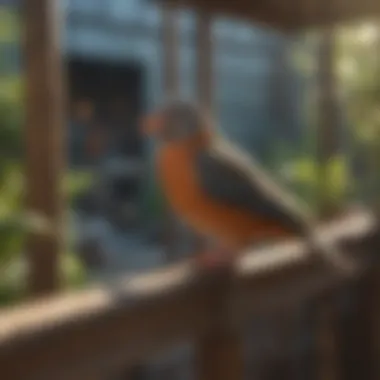
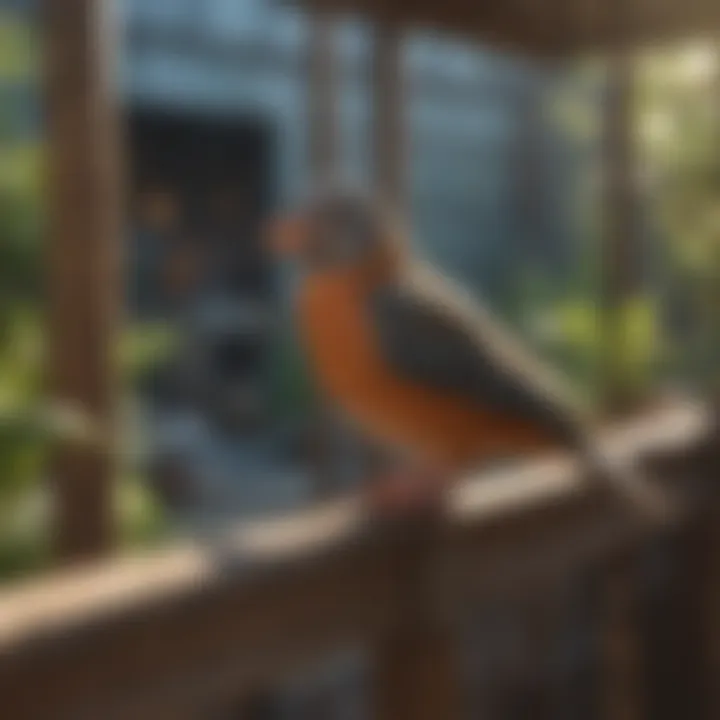
Overall, incorporating these considerations when traveling with pet birds can greatly enhance their experience. It reinforces the owner-bird connection, builds trust, and ensures the well-being of your avian companion throughout the journey.
Considerations for Multi-Bird Households
Keeping multiple birds in a household presents unique challenges and opportunities. Understanding the dynamics of multi-bird environments becomes essential for creating a harmonious living space for avian companions. Each bird has its own personality, needs, and temperaments, which can significantly influence their interactions with others.
Behavioral Hierarchies
In a multi-bird household, behavioral hierarchies often emerge. These hierarchies can dictate social interactions, access to resources, and overall well-being. Some birds may naturally take on dominant roles, while others might exhibit more submissive behaviors. It’s necessary to observe these dynamics closely.
Recognizing who interacts positively or negatively is vital. For instance, dominant birds may assert their status aggressively, which can stress more timid companions. Owners should note specific behaviors such as posturing, vocalizations, and territorial claims.
Establishing clear hierarchies can help minimize conflicts and promote a stable environment for all birds involved.
Space Sharing Dynamics
Space sharing is another critical aspect of multi-bird households. Birds require adequate room to move and engage in natural behaviors. Without proper space allocation, competition for resources can arise, leading to aggression and stress. Therefore, the layout of living spaces must facilitate unobstructed movement and create defined areas for each bird.
Consider the following strategies to promote effective space sharing:
- Design separate zones: Use barriers like furniture or different levels within the space to offer individual retreats.
- Allocate resources wisely: Ensure that food and water stations, as well as toys, are plentiful and located apart from each other.
- Monitor interactions: Take note of how different birds share space and adjust the environment based on their comfort levels.
Conflict Resolution Strategies
Conflict may arise even in the most harmonious households. As a bird owner, employing effective conflict resolution strategies can help manage disputes and keep peace among your flock. Understanding when intervention is necessary is critical. Some strategies include:
- Redirect attention: When squabbles occur, distract the birds with toys or foods to shift their focus.
- Provide escape routes: Ensure all birds have access to perches or hiding spots where they can retreat when feeling threatened.
- Individual timeouts: If aggressive behaviors persist, separating the involved birds for short periods can help them cool down and reassess the situation.
In essence, careful management of behavior, space, and conflict resolution is crucial in a multi-bird household. Ensuring that these elements are addressed can lead to improved relationships between birds and a more enriching environment for every avian companion.
Seasonal Considerations
Understanding how seasons affect pet birds is crucial for their well-being. Seasonal changes bring variations in temperature, light, and humidity that can greatly impact avian health. Owners must be aware of these shifts and how they can create suitable conditions for their birds.
Adapting to Temperature Changes
Birds are sensitive to temperature fluctuations. In winter, cold drafts can be harmful, while excessive heat in summer can lead to stress or health issues. It is important to monitor indoor temperatures carefully. Aim to maintain a steady range suitable for the species you own. For example:
- Tropical birds may require temperatures between 70 to 80 degrees Fahrenheit.
- Temperate birds usually adapt to cooler conditions but still need protection from extreme cold.
Using heating pads or space heaters during cold months could be beneficial. Conversely, in summer months, keeping areas well-ventilated or using fans can help prevent overheating. It may also help to provide shaded areas using curtains or other physical barriers.
Environmental Adjustments
Adjustments in the living environment are necessary during seasonal limitations. Light exposure varies, affecting birds' circadian rhythms. Here are key adjustments.
- Lighting: Increase artificial light exposure, especially during shorter winter days. A full-spectrum light can simulate natural sunlight and support mental health.
- Humidity Control: Maintain proper humidity levels. In dry winter months, use humidifiers to prevent dry air which can irritate the respiratory system.
- Foraging: Change foraging habits during different seasons. For example, provide access to different types of foods that align with seasonal availability.
Frequent changes in the environment may cause stress in birds. Ensuring stability with gradual adjustments can help ease any discomfort.
Seasonal Health Precautions
Monitoring your birds' health becomes more crucial with seasonal changes. Different seasons can expose birds to specific health threats. Implementing preventive care is essential.
- Check-ups: Schedule regular veterinary visits during seasonal transitions to ensure no underlying health issues arise.
- Vaccinations: Stay up-to-date on any immunizations that might be needed, depending on seasonal avian diseases.
- Diet Adjustments: Alter diet according to seasons. More fresh fruits and vegetables in summer can enhance nutrition. Conversely, in winter, higher caloric foods can help maintain energy levels.
By keeping these considerations in mind, bird owners can create a comfortable living space for their avian companions throughout the year.
Emergency Preparedness
Emergency preparedness is a crucial aspect of caring for pet birds outside conventional cages. It is essential to ensure the safety and well-being of these animals that rely heavily on their owners for protection. Having a plan in place can help mitigate potential risks, from health emergencies to natural disasters. The right strategies can make the difference in how both birds and owners cope during stressful situations.
First Aid Essentials
First aid preparedness is vital for any pet owner, particularly for those who keep birds uncaged. Birds can sustain injuries due to various factors, such as accidents or encounters with other pets. It is important to have a first aid kit that is tailored for avian care. Some essential items to include in your first aid kit are:
- Sterile gauze and bandages for wrapping wounds.
- Antiseptic solutions specifically designed for birds.
- Tweezers for removing splinters or foreign objects.
- Thermometer to check body temperature.
- Emergency avian vet contact information.
Understanding basic first aid techniques can also be beneficial. For example, knowing how to stabilize an injured bird until it can see a vet is key. Familiarity with bird anatomy aids in recognizing signs of distress and developing prompt responses.
Evacuation Plans
Crafting an evacuation plan is another important factor in emergency preparedness for uncaged birds. Situations such as fires, floods, or other disasters necessitate swift action. Pet birds often need different handling compared to traditional pets due to their unique flight abilities and stress susceptibilities. Key elements of an evacuation plan include:
- Identifying safe exit routes from your home that allow for quick access.
- Designating a secure transport container to safely carry your birds.
- Practice drills to ensure all family members know the plan.
- Emergency contacts, including local shelters and pet-friendly hotels.
Always ensure that you have a current photo of your birds and any applicable medical records. This documentation will facilitate treatment in case of separation during emergencies.
By outlining these plans in advance, you can reduce chaos during an actual emergency and ensure that your birds are taken care of.
Vet Emergency Contacts
Maintaining a list of vet emergency contacts is essential for responsible bird ownership. In emergencies, swift communication with veterinary professionals can be lifesaving. It is ideal to know not only your regular avian vet but also nearby clinics that provide emergency services. Consider the following:
- Compile a list of trusted veterinarians, including their phone numbers and addresses.
- Include after-hours clinics that specialize in birds.
- Ensure you know the contact details for any specialists your birds may require.
Having this information readily available can expedite treatment and provide peace of mind during stressful situations. In emergencies, every moment counts, so always be prepared.
The Future of Cage-Free Pet Bird Care
The concept of keeping pet birds without cages is becoming more prevalent as awareness of avian welfare grows. As pet owners seek better living conditions for their birds, it becomes crucial to consider the future pathways for cage-free care. This involves examining innovative solutions that accommodate the needs of birds while recognizing owner responsibility. Fostering an understanding of how to create safe, enriching environments is just as important as the benefits it brings to bird health and well-being.
Innovative Living Solutions
Innovative living solutions for cage-free birds emphasize environments that mimic natural habitats. An open floor plan within the home can allow birds to explore and engage with their surroundings actively. Utilizing high perches, climbing structures, and foraging areas enriches their experiences and sustains their physical and mental health.
Some of the innovative ideas include:
- Aviary Spaces: Outdoor or indoor aviaries provide enough freedom for birds to fly. These spaces can be designed to include natural vegetation, appropriate shelter, and foraging materials that mimic natural conditions.
- Mobile Perches: Creating mobile perches allows birds to move around the house safely. These can be attached to both walls and furniture, giving birds the freedom to choose their location.
- Outdoor Time: Arranging safe outdoor environments offers birds a chance to experience fresh air and natural light. This should always be supervised and secured to prevent escapes or encounters with predators.
Community Initiatives
Community initiatives play a critical role in promoting awareness about the benefits of cage-free bird care. Local bird clubs, shelters, and rescue organizations can provide resources and support for owners who wish to pursue this lifestyle. These communities often host events and workshops focusing on bird welfare and safety in an uncaged setting.
Important community-driven activities include:
- Workshops and Training Sessions: Educating pet owners on necessary care techniques facilitates better practices for those considering a cage-free approach.
- Support Groups: Establishing online forums or local meet-ups fosters interaction, allowing owners to share experiences, tips, and result of their approaches.
- Advocacy Programs: Promoting legislative changes regarding bird welfare encourages more pet owners to adopt cage-free practices within governed guidelines.
Shaping Policies and Practices
The evolution of policies concerning animal welfare reflects society's growing understanding of the needs of pets, including birds. Policy makers and advocacy groups should aim for regulations that protect birds in cage-free environments, ensuring their welfare and safety.
Key aspects to shape policies include:
- Health and Safety Standards: Implementing guidelines to determine safe environments for uncaged birds establishes a baseline for quality care. This could include minimum space requirements, supervision protocols, and veterinary care obligations.
- Research and Data Collection: Scientific studies on the health outcomes of cage-free birds can inform both pet owners and legislature about best practices and the effectiveness of different living arrangements.
- Public Education Campaigns: Educating the public about the realities of cage-free bird care can encourage responsible pet ownership and promote informed choices for potential bird parents.
"The future of cage-free pet bird care hinges on community involvement and informed decision-making. Owners must understand their role in creating safe and stimulating environments for their birds."
Through collective efforts, informed decisions can promote better living conditions for our avian companions, ensuring a sustainable, enriching future for both birds and their owners. Adopting a cage-free lifestyle is not just a trend; it is a commitment toward more humane treatment of pet birds.















